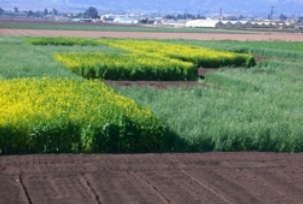
Features
Business
Food Safety
Cover cropping can optimize organic production
February 4, 2013 By USDA-ARS
 A field test site in Salinas, CA, showing a checkerboard of different cover crop treatments being tested, including mustard (yellow flowers), rye, and fallow. USDA-ARS
A field test site in Salinas, CA, showing a checkerboard of different cover crop treatments being tested, including mustard (yellow flowers), rye, and fallow. USDA-ARSFebruary 4, 2013 – Farmers can fine-tune their use of cover crops to help manage costs and maximize benefits in commercial organic production systems, according to U.S. Department of Agriculture (USDA) scientists.
Production expenses for high-value organic crops like lettuce and broccoli can exceed $7,000 per acre, so producers often try to streamline costs with an annual two- to three-crop rotation. Agricultural Research Service (ARS) horticulturalist Eric Brennan designed a long-term investigation that examined several different cover cropping strategies for an annual organic lettuce-broccoli production system.
The researcher selected three winter cover crops often grown in the Salinas, CA, area — rye, mustard, and a legume-rye mix — and planted each cover crop using either a typical seeding rate or a seeding rate that was three times higher. Seeding rates can influence a cover crop’s ability to smother weeds.
During lettuce and broccoli production, Brennan ensured all systems received the same fertilizer and irrigation inputs and pest management.
Brennan’s results indicated that all three cover crops yielded more dry matter than the two tons of crop residue per acre often recommended for maintaining soil organic matter. The legume-rye and rye cover crops produced approximately 25 perc ent more dry matter biomass than the mustard crops. But effectively suppressing weeds with the legume-rye crops required seeding at three times the typical rate, while rye and mustard crops appeared to suppress weeds adequately with typical seeding rates.
The long-term study also provided Brennan with more data about year-to-year yield variations in the legume-rye mix, including why legumes, which make up most of the seed costs, are not consistently abundant. Brennan thinks cooler early-season weather helps legumes compete with the rye. So when a hot and dry autumn is expected, producers might want to use a rye cover crop and skip spending the money on a cover crop with legumes.
Brennan, who works at the ARS Crop Improvement and Protection Research Unit Crop Improvement and Protection Research Unit in Salinas, has published some his findings in Agronomy Journal and Applied Soil Ecology.
Print this page